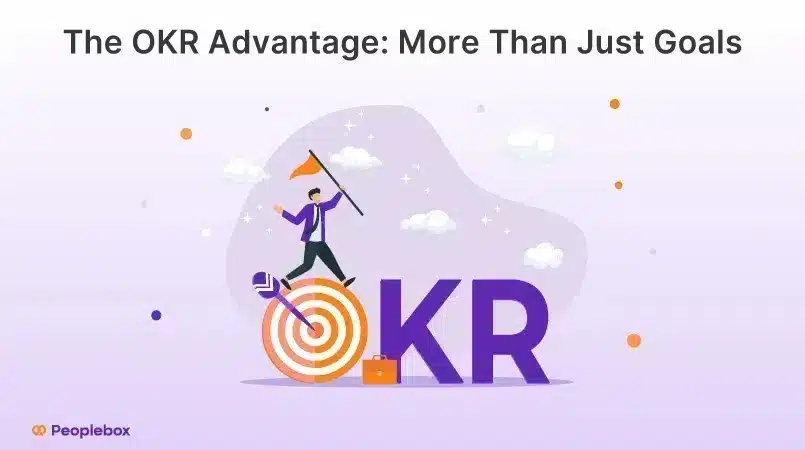Businesses often fall into the trap of considering ‘Usualness’ as high performance. This happens in the absence of clarity, goal alignment, and capability challenges. Instead of focusing on 10x impact projects, most efforts get invested in restoring standard performance. High-performing successful businesses, instead, focus on leveraging problem-solving and business goals.
That is where OKR comes in. As a business, every employee of your company must be working in the right direction. OKR, or Objectives and Key Results, provide clarity of direction for producing measurable results. This is why companies like Google, Amazon, Netflix, Facebook, LinkedIn, Microsoft, and YouTube all follow OKR methodology.
In this blog, we will answer everything that you need to know about OKR. OKR means business, its method, why it is important, why your company needs OKR in place, and how you can write your OKR perfectly. We will also tell you the best OKR tools available for your business.
OKR Meaning
OKR or Objectives and Key Results is a goal-setting framework used by organizations to define and track objectives and their outcomes in a clear and measurable way. The OKR methodology was popularized by Andy Grove at Intel and later adopted and refined by companies like Google.
“Objectives” represent ambitious and qualitative goals that describe what an organization or team aims to achieve.
“Key Results,” on the other hand, are specific, measurable, and time-bound outcomes that are used to assess progress toward achieving the objectives.
OKR is a simple and effective way to achieve strategic goals by driving better focus, aligning teams, building measurable actions, and fostering accountability and transparency in strategy execution. The Objectives and Key Results are the two components of this methodology. The objectives are the endpoint meaning what you want to achieve, and the key results are the deliverables defined for the objective.
Objectives are short and inspirational, and there should only be 3-5 high-level objectives per quarter. For example: Improve Profitability in order to ensure the best IPO
Key results are to measure your progress. Each objective should have 3-5 key results, and they all should be measurable. For example: Improve the NPS score from 2.3 to 8.5
Why do you need OKRs?
Those who set actionable tasks for their goals and track their weekly progress with their supportive peers tend to achieve 40% more than those who don’t, says a Goal Research study by Gail Mathews. This proves that having clear goals, and tracking and reporting them substantially increases your chances of achieving them. OKR specifically works on defining goals and ways to achieve them by providing direction to your company. It creates an awareness of company goals and ensures that all the employees are working towards achieving them. It encourages documenting the progress and measuring them in real-time.
Focus on only what matters
OKR creates intense focus on what matters most. It creates an environment where everything is directed towards being result-oriented. The OKR method is not for ‘business-as-usual’ where everything happens just to keep things running. Instead, the purpose of OKR is to attract business growth. It singles out areas of improvement. It facilitates identifying problems that need addressing and involves brainstorming ideas for improvement.
It breaks down the big picture into smaller pieces as tasks. The completion of this culminates in the big picture. Breaking down into smaller tasks makes them achievable and helps focus on one task at a time. The teams can focus more and work better on one task that is very small, precise and achievable.
Stay aligned with strategic objectives
Most companies want to implement OKR to align everyone working in the company to give it a unified direction. It helps set objectives for every level of the organization aligning with the overall vision and strategic priorities. This does not mean that every team will have the same OKRs. Every team might have different OKRs aligned toward achieving the larger objective of the organization.
OKR creates a team that collaborates well and understands its roles in achieving strategic objectives. And when all the teams successfully achieve their OKR, they contribute to the achievement of the company’s OKR.
Maintain transparency
Achievement of company goals requires collaboration and everyone moving in the same direction. You achieve this through transparency in the entire organization. It requires sharing ideas and connecting or complementing each other at work. It is like the puzzle pieces coming together to finish the game. Be transparent in sharing the company objectives, problems, areas of improvement, hurdles in the organizational process, etc.
It also involves sharing ideas and participation in team discussions. Maintaining transparency nurtures a healthy relationship in the organization. It builds trust, effective communications, connecting suggestions, and productivity improvement.
Drive actionable results
OKR aligns the different goals to work together towards one common goal and drive valuable outcomes. It helps you to determine if you have reached your goal by driving actionable, result-oriented task planning. It gives you a clear point of reference to determine how well your team is performing and how much you have progressed with respect to your goals.
How to write OKRs?
We know that well-written OKRs give you a sense of direction, enable you to focus on what is important, and prioritize your actions towards it. A well-written OKR will have a well-outlined path to achieving your goals. It defines how to get to your goals. It lets you track your progress with the right metrics, leading you toward effective decision-making.
Poorly written, difficult-to-grasp OKRs, on the other hand, might put all your efforts in the wrong direction. This can cost you time and effort and ultimately demotivate you to use OKR methodology as it will fail to contribute to your progress.
It takes critical thinking, a lot of time, and experience to write OKRs.
As a simple rule, you must have 3 objectives for a defined time period, and each objective should have 3 or 5 key results. If you put it into this simple formula, you will find your OKR.
OKR= What + 3 (How)
Here, What is your Objective, and How are the Key results.
Writing objectives
Objectives should be inspiring and should express your intent. It should invoke emotion and encourage your teams to become a part of your objectives. Typically, 1 to 3 objectives per team per quarter are ideal. However, the exact number depends on the need of the company. They answer the questions:
- What needs improvement to be successful?
- Why is it important?
Writing key results
Quantitative key results help you measure your progress toward achieving your objectives. This is why when writing key results, define the definite metrics. This makes it easy to communicate progress. Each objective should have 3-5 key results. They should answer:
- How to improve?
- How to measure it?
Writing company OKRs
Company OKRs are high-level goals towards which every team contributes with their projects and daily work. It should be specific and yet distributable into smaller OKRs. This provides everyone with a clear understanding of the direction they need. A good leadership team will always take feedback from teams before finalizing its objectives. They will clarify their expectations from everyone.
- Understand your company goals
- Break those goals down into actionable team OKRs to drive action
- You cannot isolate company OKRs. They will always ladder up onto each other.
- OKRs are bi-directional and not only top-down, which means each team member should and can share inputs into OKR.
Example:
Objective 1: Crack US Enterprise Market to increase ARR from 2mn USD to 20mn USD
Objective for the sales team: Achieve 18mn USD in ARR from US enterprise market
Objective for product team: Make Product Enterprise Ready
Objective for Customer service team: Improve customer onboarding experience for enterprise companies
Objective 2: Emerge as a leader by winning over the B2B tech market
Objective for the sales team: Increase the MRR by $100k
Objective for product team: Launch the top 10 most demanded integration
Objective for marketing team: Build pipeline for achieving highest closing rate ever
Objective 3: Increase Customer Delight to achieve upselling targets by $50k
Objective for the sales team: Train 100% of the sales team on updated sales roadmap
Objective for product team: Achieve NPS of 75+
Objective for customer service team: Increase daily active users by 80%
Writing team OKRs
Team OKRs work for company OKRs and should encourage the teams to focus on solving the problem. These are high-impact problems to deal with during the quarter and produce results.
- Measurable metrics for the team to see their progress
- Focus on outcomes instead of tasks
- Set benchmarks and monitor the time-bound objectives of the team
Example:
Sales team Objective: Increase the quarterly sales revenue to $100k
Key Results: Ensure 80% of the sales team achieve their quota
Key results: Improve the win rate by 70%
Key Results: Increasing the demo conversion rate from 40% to 50%
Product Team Objective: Become the most loved product
Key Results: Improve weekly active users by 30%
Key Results: Improve monthly active users by 15%
Key Results: Work with the marketing team to develop customer-facing campaign highlighting the identified advanced features
Marketing Team Objective: Improving brand awareness and popularity
Key Results: Improve sign-up numbers by 40%
Key Results: Increase the website traffic by 30% by publishing 4 blogs posts
Key Results: Increase Linkedin followers to 150k
Tips to write OKRs
Be specific with your OKRs
They should not be ambiguous at any point. Be very specific with your objectives (where you want to reach) and the key results (how you want to reach there).
Set realistic expectations
It is easy to get carried away when setting objectives. But stick to prioritizing realistic objectives instead of impossible ones. You cannot have too many priorities at a time and not achieve any of them.
Follow a top-down approach
Start OKRs from the top level of the organization and move down to departments, teams, and individuals. This gives a clear outline of how everyone is contributing to the growth.
Break down larger goals into smaller ones
Mini goals are manageable. So, for example, instead of just setting your OKR as Increasing Revenue, divide it into small goals for achieving the revenue goal.
Mistakes to avoid while writing OKRs
Mistakes are inevitable when embarking on the OKR journey, but there are certain mistakes that you can avoid.
- Having too many priorities. It will confuse everyone. No one will be able to see the clear goal with too many important goals and tasks.
- Define OKRs for a quarter, not the entire year, to break down the process.
- Follow the ideal number of objectives and key results formula: 3 to 5
- Create achievable goals and not impossible-to-achieve goals
- Setting only top to down objectives instead of bi-directional objectives
- Make it time-bound and take the initiatives to help the teams achieve their KR
- Do not fail to track progress by checking-up weekly to ensure everything is fine-tuned.
Best OKR tools for your business
Peoplebox
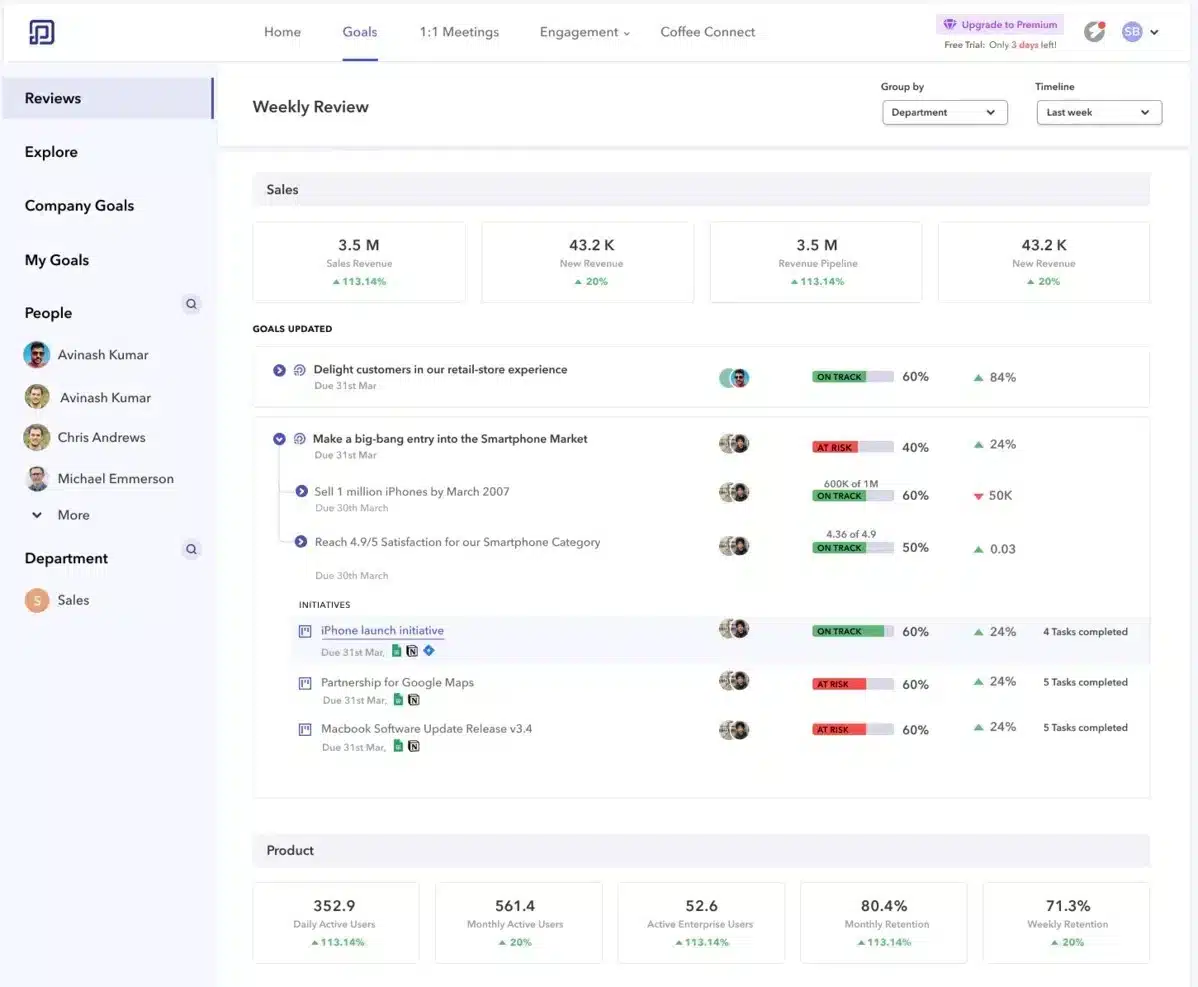
Peoplebox focuses on strategy execution with exceptional OKR implementation for enterprises. It offers a centralized system to streamline departments and teams for seamlessly executing OKR strategy. It enables the teams to focus on strategic priorities and gives a unified view of the progress by tracking cross-aligned goals. It aligns and tracks team goals, initiatives, and offers real-time insights with a clear view of the progress made. It enables OKR to be a central part of the company’s goal-setting process and empowers growth.
Features
- It offers real-time tracking of strategic plans, goals, and initiatives progress.
- It offers seamless data integrations
- Allows you to see the overall picture of your organization on a single page
- Easy integration with Slack, Asana projects, and other apps for better OKR adoption
Pros
- Easy syncing of all members of the organization on a single task or project
- User-friendly easy interface
- Business review option with automated custom dashboards, charts, KPIs, action items, etc.
- OKR check-in cycle feature which tracks progress in details
Cons
- Peoplebox.ai is a comprehensive tool with multiple features. Hence, it can be overwhelming for hiring managers to use this tool at times.
Profit. co
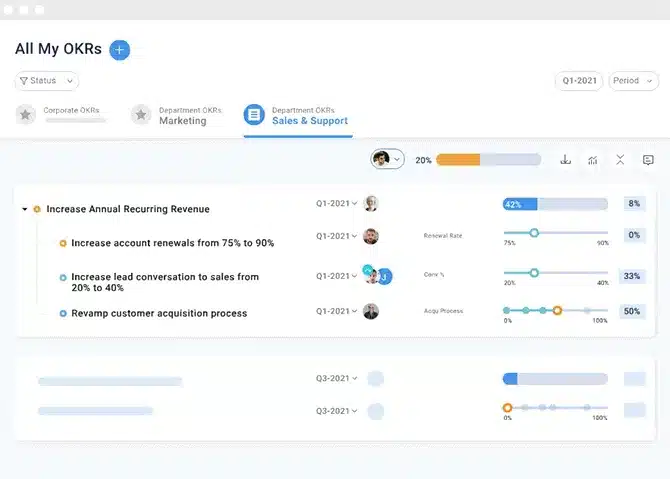
Another great platform offering easy execution of OKR with weekly check-ins and reviews. It lets you manage everything from a single platform strategy, OKRs, people, and performance. They also have an in-house onboarding team that helps you in creating powerful OKRs.
Features
- It offers alignment dashboards that give company overview of the entire company
- 400+ inbuilt and custom KPIs for easy key result setting
- Offers customization for creating OKR period and performance review cycle
Pros
- Weekly check-ins for progress tracking
- Option to export files for individual department’s performance assessment
- Real-time heatmaps for identifying bottlenecks faster
Cons
- Lacks integration with project management tools like Trello, Asana
- Tasks are not visible in the Gantt chart view
Workboard
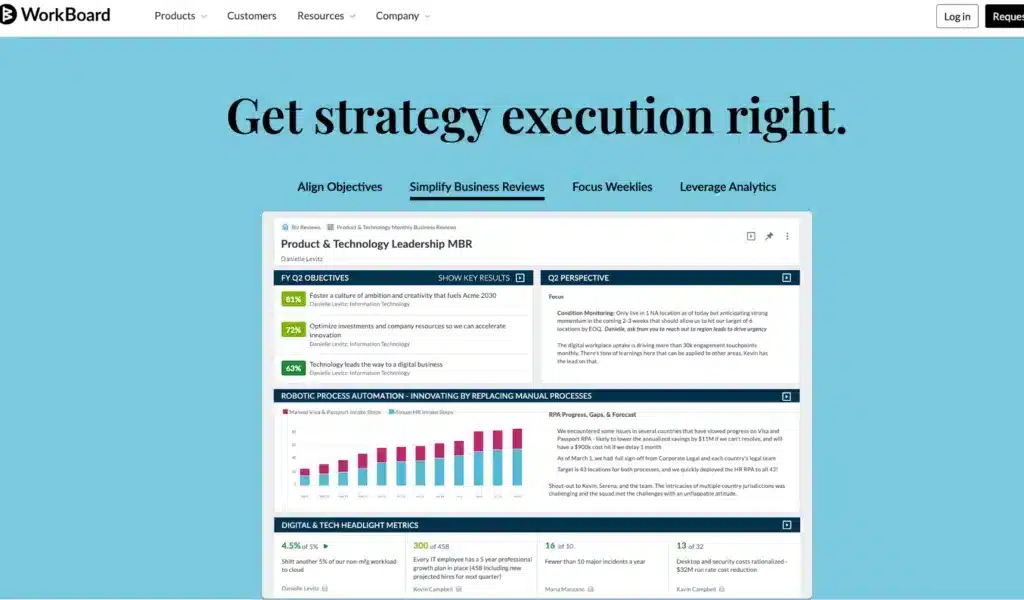
This platform offers a good OKR framework with examples for aligning teams and achieving faster goals. It helps in articulating objectives and shifting focus on the key results. It makes alignment and accountability easy, and offers insights and heatmaps for measuring results.
Features
- Offers easy collaboration, file sharing, 1:1 meetings, etc.
- Automatic group meeting minutes recording and publishing
- Creation and tracking of projects aligned with OKR
- Single-click sharing of OKR, strategic plans, etc.
Pros
- A feature-rich all-in-one platform
- World-class customer success team to help understand OKR and implement it
- Exceptional automation between major features and capabilities
Cons
- A lot of times the software faces downtime and gets slow
- Not very intuitive and sometimes sacrifices user experience
Asana
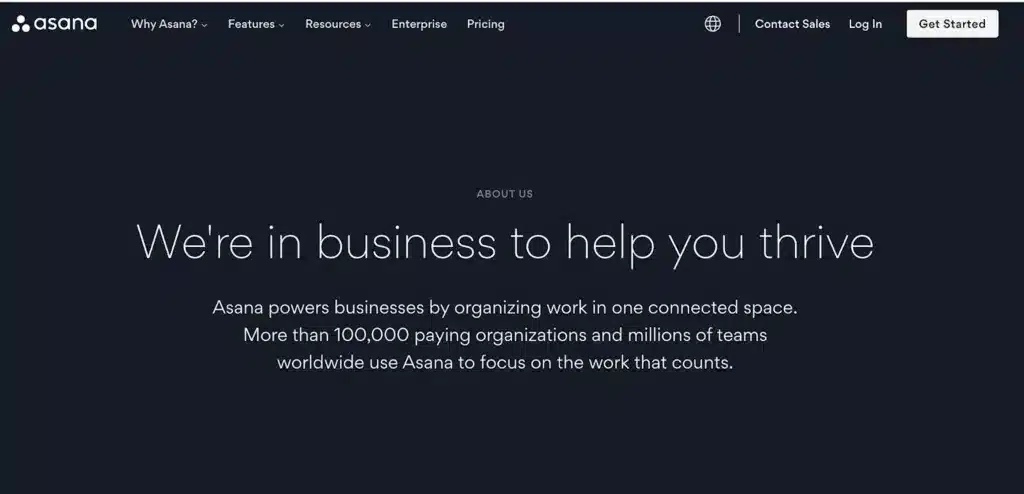
It is a task management app with OKR as one of its features to help achieve goals faster. It helps organizations to understand the interrelations between goals and daily operations.
Features
- End-to-end project management
- Seamless communication channel with all important documents and communications organized in tasks, and projects
- Templates for standardized projects and processes for teams to use
- Monitor OKR progress in real-time with portfolios
Pros
- Custom fields to add additional data to tasks.
- Easy assessment of team’s bandwidth with Workload feature
- Templates for the achievement of company and team goals
Cons
- It lacks a lot of OKR functionality as it is a core project management tool
- Restriction on assigning tasks to multiple team members
- It has a learning curve, and it takes time to understand the interface completely
Final words
OKRs are highly effective in driving performance and growth. OKR’s meaning in business is defined by how well it clarifies what to do for everyone and how it transforms the direction of a company from business-as-usual to a goal-oriented business. Large-scale companies use the OKR method to align goals and encourage success.
It is time to apply this highly constructive method in your company and accomplish your big company goals. While it might seem a little intimidating but with the right tool and the right guidance, you can successfully implement OKR.
To understand how OKR can enable better performance in your company and help you accomplish your objectives, you can book a demo with Peoplebox.ai. You can also talk to a specialist to assess your organization’s OKR requirements to assess the difference it can make in your business performance.
Schedule a demo now!

